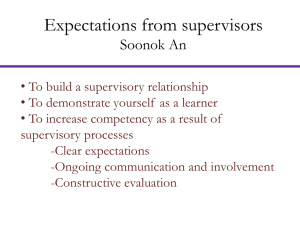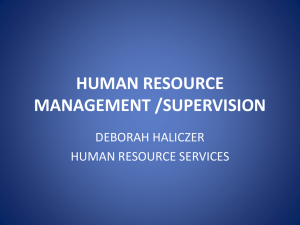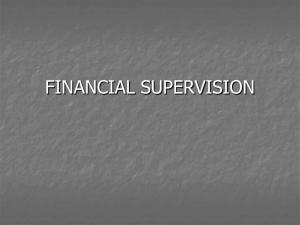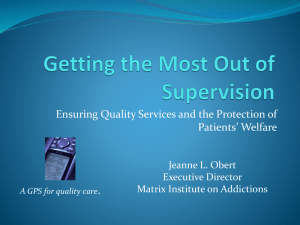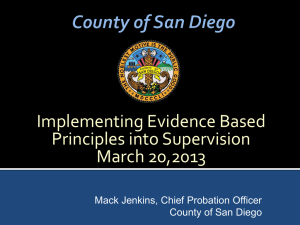CDI Module 12: Introduction to Health Services
advertisement
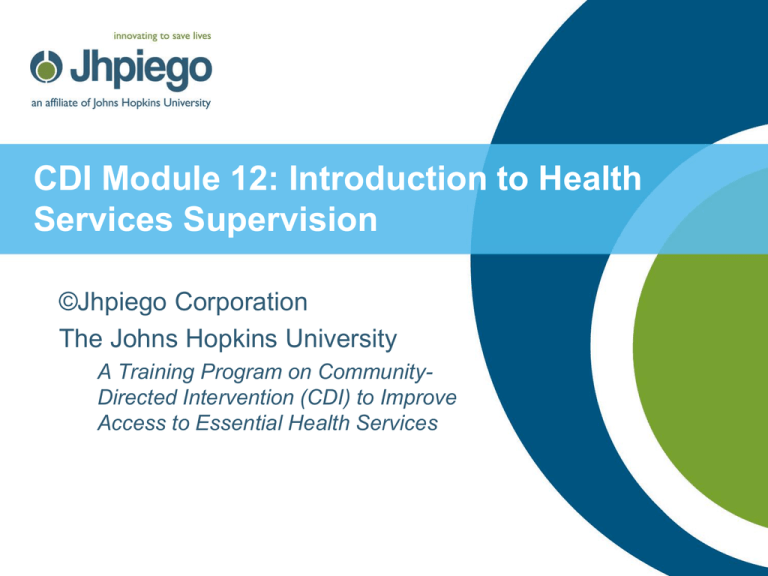
CDI Module 12: Introduction to Health Services Supervision ©Jhpiego Corporation The Johns Hopkins University A Training Program on CommunityDirected Intervention (CDI) to Improve Access to Essential Health Services Module 12 Objectives By the end of this module, learners will: Differentiate between traditional and supportive supervision Define supervision Describe who is a supervisor and the supervisor’s responsibilities Describe the skills and personal characteristics expected of a supervisor 2 Module 12 Objectives (continued) By the end of this module, learners will: Define desired standard performance State the relationship between training and supervision Describe the use of checklists during supervision and assessment for quality improvement Describe the process of root cause analysis and selection of problem-solving interventions 3 How Do Site Staff React to the Arrival of the “Traditional” Supervisors? Let’s run. Those guys are here again! TS RURAL HEALTH CENTER THE TRADITIONAL SUPERVISORS 4 How Do Staff React to the “Supportive” Supervisor? SUPPORTIVE SUPERVISOR Hi, Everyone. PARADISE HEALTH CENTER Mike, we are glad to see you. 5 What Is Supervision? Health services supervision is defined as: “A process of guiding, helping, training and encouraging staff to improve their performance in order to provide highquality health services” 6 Two Crucial Levels of CDI Supervision Supervision of the community-directed intervention (CDI) process at the frontline health facility Supervision of the CDI process in the community 7 Who Supervises? Supervision is carried out by a person who is responsible for the performance of clinical and non-clinical staff Supervision can be conducted internally by an on-site supervisor or externally by someone who makes periodic supervision visits Community-directed distributors (CDDs) can supervise themselves and each other by discussing and assessing their performance at their regular meetings 8 Internal and External The internal, or on-site, supervisor conducts supervisory activities as part of everyday activities Many internal supervisors also provide clinical services at the site External supervisors periodically visit health care delivery sites—where they do not work on a day-today basis—to help staff improve and maintain performance and quality A CDI focal person at a frontline facility is an “external” supervisor to the community 9 Defining Supervision A supervisor may: Supervise from one person to many people Work at a small rural health post or a large regional hospital Be a clinician, public health technician or other health care worker Work at a clinical site and supervise people at that site, or work at a district or regional level and conduct supervision through visits 10 Defining Supervision (continued) A supervisor may: Have the word “supervisor” in her/his job title, or be called a manager, an “in-charge” or something other than supervisor Have received some formal training in supervision, or have had no training in how to supervise people 11 Supervisor Responsibilities Supervisors: Identify standards of good performance and communicate to staff members Work with staff to assess their performance, periodically, compared to these standards Provide feedback to workers about their performance 12 Supervision Solves Problems Supervisors work with staff and the community to: Identify appropriate interventions that will lead to improved worker performance and delivery of high-quality services Mobilize resources from many different sources to implement interventions Ensure that interventions have had the intended effect 13 CDI Meetings Raise Common Problems and Seek Solutions 14 Supervisor Skills Supervisors: Demonstrate technical competence Facilitate team building Motivate others Facilitate meetings and discussions Identify strengths of staff members and build on positive aspects Provide constructive, timely and interactive feedback Communicate effectively with staff and decisionmakers Delegate duties to staff 15 Supervisor Personal Characteristics A supervisor has: Leadership skills and the ability to inspire others A desire to help others achieve their full potential A commitment to the provision of high-quality health services Openness to new and creative ideas 16 What Is Supervision for Performance and Quality Improvement? This type of supervision: Has the goal of providing high-quality health services Uses standardized performance criteria Is a process of continuous performance and quality improvement Is a style of encouraging, inclusive and supportive interaction Involves the people being supervised in identifying their own needs and planning improvements 17 Performance Improvement Framework Get and Maintain Stakeholder Agreement Consider Institutional Context Mission Goals Strategies Culture Define Desired Performance Find Root Causes Select Interventions Implement Interventions Describe Actual Performance Client and Community Perspectives Monitor and Evaluate Performance 18 What Is Desired Performance? To perform well, people must know what they are supposed to do Performance standards need to be set Staff must know not only what their job duties are but also how they are expected to perform them Desired performance should be realistic and based on the shared vision, the expectations of the community and the resources at your site 19 Relationship: Training and Supervision Training Objectives and Tasks Performance Standards 20 Assess Performance Your team will need to assess, continually, how team members are performing compared to how they are expected to perform This assessment can be done on an ongoing basis, informally, or more formally on a periodic basis, by observing staff, conducting selfassessments or obtaining feedback from clients Performance assessment is equivalent to post training evaluation and can lead to diagnosis of new training needs 21 Types of Supervisory Tools A supervisory tool is often a checklist that guides both the supervisor and the staff to review the: General environment where services are provided Correctness and completeness of recordkeeping systems Availability of supplies, materials and equipment Performance of basic service provision skills It helps if checklists or guidelines are available so that everyone can review and mark these together After using the checklists, everyone should sit together and discuss the results (Pass around copies of tools actually used in your country and talk about them) 22 Example of Simple Checklist on Malaria in Pregnancy Services Malaria in Pregnancy Control Tasks to Be Observed Provision of IPTp Verification Criteria Observed, Satisfactory (2) Observed, Unsatisfactory (1) Not Observed (0) Comments Determine eligibility for an IPTp dose Give IPTp with DOT Counsel on subsequent IPTp Record provision of IPTp Provision of ITN Determine eligibility for ITN according to availability and use of ITN in the home Provide ITN as needed Counsel on ITN setup and use Record provision of ITN Case Management Use appropriate diagnostic tools—lab blood film examination or RDT Treat with appropriate anti-malarial according to trimester Counsel on adherence/compliance to full course of treatment Give supportive care as needed (e.g., for anemia) Record provision of malaria treatment 23 Find Causes of Performance Gaps A performance gap exists if your team finds that what is actually occurring does not meet the performance standards that have been set If you find that this is the case, then you need to explore carefully with staff why the gap is occurring—what is hindering desired performance Sometimes the reasons for poor performance are not immediately obvious, and it may take some time to find the real cause 24 Selecting and Implementing Interventions Once the causes of the performance gap have been determined, you and your staff will need to identify, put in order of priority, plan and implement interventions to improve performance These interventions can be directed at improving the knowledge and skills of staff, or they can be directed at improving the environment or support systems that enable staff to perform well Many different types of interventions can be put in place to improve worker performance To save resources, it is important to select the correct interventions 25 Monitoring and Evaluating Performance Once interventions have been implemented, it is important to determine if interventions have had the desired result Did the intervention cause performance to improve? Did it move you closer to meeting the established standards? If not, your team will need to look at what is hindering performance to make sure the interventions are appropriately targeting the real cause of the performance gap If performance has improved, it is important to continue monitoring to make sure the desired level of performance is maintained 26 Summary Supervision is a process of guiding, helping, training and encouraging staff to improve their performance so that they can provide highquality health services It is not fault-finding and reprimanding 27
